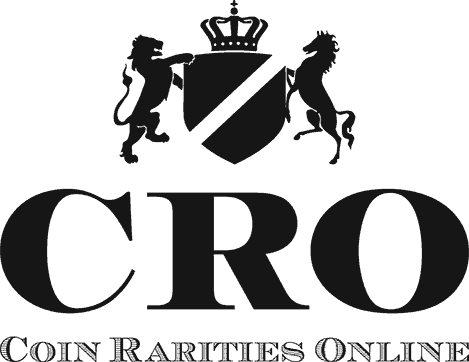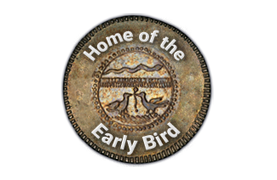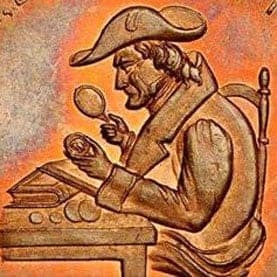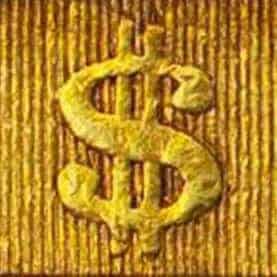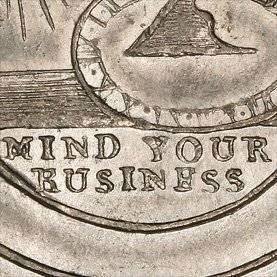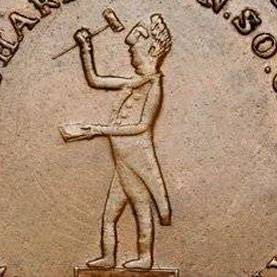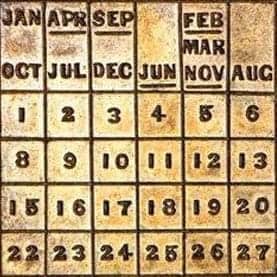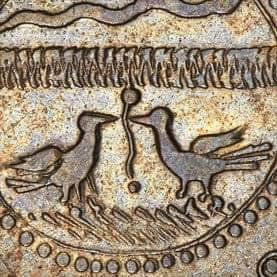September 22-26, 2009: The Whitman Philadelphia Expo
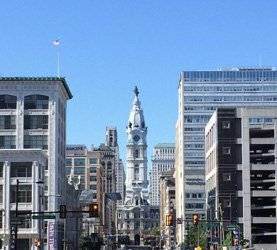
Prologue
In just a few minutes we’ll be officially on the road (again), heading down to the first ever Philadelphia Coin & Currency Expo (and the associated Bowers and Stack’s sales).
And our expectations are this high (hand held about 6 feet off the ground), since a lot of interesting stuff is being auctioned, this should be another good east coast venue and Whitman is really good at running these things.
And of course Dave and I will be here for the duration, from the exciting hammering of the first Bowers lot on Tuesday afternoon until they vacuum the bourse floor on Saturday evening, buying, selling, trading, grading, wheeling, dealing and writing (as in the RR, which will be posted here every morning for your reading pleasure).
As always, our goal is to fill this space with entertaining, insightful (and occasionally inciteful) comments about everything we see and do on this trip, which you can start reading right here in about 24 hours from now.
September 22nd: The Burrito
Other than the fact that the woman next to me at the airport departure gate was eating a giant and utterly repulsive burrito (at about 5 in the morning), Tuesday’s travel was pretty uneventful.
Landing at 8:30, I cruised into downtown Philadelphia in an unusually clean taxi, checked into my hotel, was delighted to find out they had a room ready for me and had a leisurely cup of coffee before heading over to the convention center at 10ish.
Figuring out where to go when I got there proved more challenging, since neither Stack’s nor Bowers (both of who were conducting simultaneous lot viewing) posted any signs indicating where they were. Which caused me to wander around like an idiot through a large crowd of people there for some kind of medical conference before stumbling upon the Bowers lot viewing room purely by accident at the end of a hallway.
And it wasn’t terribly crowded when I got there, with only a few Bowers staff present and just Tom Caldwell of Northeast Numismatics looking at coins.
That worked out well, though, since I got zip through all of the lots pretty quickly, rarely having to wait for any boxes (unlike the guys who arrived later after the room began to fill up), took notes, figured out what we would be chasing and generally accomplished a lot.
With special emphasis on some interesting items in the colonial section. Including some very highly graded pieces that had been on the market in recent years, some of which were described (in your author’s humble opinion) as quite a bit better than they really were, but which were noteworthy nonetheless.
But while there were a few coins in the session we could have chased, we ultimately decided to focus on some of the more affordable pieces and pass on the expensive stuff, bidding instead for a dealer friend and saving our own ammo for some high end colonials we’ve been offered privately.
And some might say that was a mistake, since a few of the coins in this session went for what seemed like very reasonable numbers (at least compared to their previous auction appearances):
Lot #10, the very weakly struck but technically high grade Willow Tree Shilling brought “just” $106,375, compared to the $184,000 it brought as a raw coin in the Ford sale in October 2005 and the $230,000 it brought at Heritage in January 2007. A bargain, right? Hmmm. To be honest I never really understood those earlier values for this coin (since much of the planchet on this piece is completely blank). And apparently I was not alone.
Lot #15, a mottled and not all that attractive Maryland Shilling graded PCGS MS61 and called “probable finest known” (even thought it isn’t really close to the best) brought $57,500. That’s nearly $20,000 less than the sharper but equally unoriginal NGC AU58 example at Heritage in April 2008 and almost $70,000(!) less than the far superior PCGS AU58 piece sold at Heritage in January 2008, but even at today’s relatively low price, we still didn’t like it.
Lot #40, an unusually colored AU58 example of the not-all-that-popular Texas Jola sold for $28,750, which is a well less than the high water mark for this issue when this same coin sold for $80,500 at Heritage just 19 months ago. Surely that was a good deal, right? We viewed it as fair value, with the earlier much higher price most likely a result of auction fever and a price we’re not likely to see again anytime soon.
But many of the rest of the ‘big’ colonials were more appealing, and brought more typical prices, with some getting fairly close to their last auction records (set during the market peak), or actually exceeding them.
The federal material was about as familiar looking and generally less interesting, though we did find a few things we liked, left some widely spaced bids on select type coins and then moved over to Stack’s viewing down the hall.
Which was a far more challenging task, since the catalog was thick and filled with all sorts of slabbed and raw colonials, unusual tokens and medals and generally things that take a lot more time to view, digest, grade and evaluate.
But we spent the rest of the afternoon doing it, and got through most of what we needed to do. Plus we had to leer over cool stuff like the gold Indian Cent (though we will reserve any specific comments on that or anything else in the catalog until the auction is over).
After which we walked around aimlessly before bumping into a very good Italian restaurant for dinner, had a reasonably healthy meal and headed back here to the hotel for some deluxe RR writing.
Wednesday we look forward to dealer set-up, some buying and selling and some final Stack’s viewing to get ready for that session on Thursday.
All of which will be reported, right here, tomorrow.
September 23rd: The Heat Wave
Here was the plan for Wednesday:
Wake up really early, go to the gym here at the hotel, efficiently get some work done, meet Dave for a healthy breakfast, head over to the show just as it opens, sell a bunch of coins, buy all sorts of cool stuff, and call it an early night.
And here’s what actually happened:
Woke up about 15 minutes before I was supposed to meet up with Dave in the lobby, ran around like crazy getting ready, tried to print something in the business center here at the hotel and discovered that 2 of the 3 computers did not work and all of the printers were out of paper (and ink), ate a plate of what I think was synthetic corn beef hash in 40 seconds, got to the show a little late and had to stand at the end of a giant line, realized we forgot the electrical strips and walked back to the hotel to get them, indulged in a Philly cheese steak sandwich lunch provided by Whitman gratis for the dealers, sold 3 coins and bought 11, and then started slogging through a massively enormous deal of early copper all in a bourse floor that was kept at a delightful 96 degrees all day. We did call it an early night, though, so that worked out well.
There was, however, and despite the heat, some actual buzz on the bourse floor, indicating wholesale activity taking place all over the room (unlike the recent California shows during which you could hear only the sound of the air conditioning).
Which is not to say that it was super busy or active on this day (at least for us). Just enough to make it interesting, to allow us to pick up some pretty cool NEWPs for the next Early Bird, and to give us some confidence that Thursday could be good – especially with the addition of some more retail traffic.
It is also fixing to be very long, with a full day on the bourse floor followed immediately by the Stack’s colonial auction session starting at 6:30 PM and continuing into the wee hours.
Which means that I really need to get some rest right now.
September 24th: The $276,000 Question
Little bit of a rocky start on Thursday.
Woke up at 4:08 AM, fired up the coffee pot – or tried to, actually – since it was not working. Which is a significant problem at that time of day.
But I did without, finishing the blog hastily, answering a bunch of emails, and eventually heading down to breakfast at 6. At which time I met up with a dealer friend who happened to be there, and who then proceeded to tell me a bunch of numismatic horror stories over artificial eggs. And that’s always fun.
Shaken, I went back upstairs for a while, eventually meeting Dave in the lobby some two hours later and then migrated over to the show for the 9 AM start.
And from there on, things went a whole lot better. We sold some cool stuff, bought many more nice pieces, one of which we had been trying to buy for no less than 6 months, and another which will soon be appearing in a CRO ad near you.
Then while Dave kept working through that massive copper deal, I went to check out the unique Nova Constellatio pattern set on display (which is certainly worth the effort), and then spent a cumulative hour or so at the PCGS table submitting and/or picking up coins. Most of which turned out just fine.
Then we finalized our Stack’s bidding plan and, at the end of the day, went to the auction and bought a couple more things that we liked in a session that was a complete and total mixed bag of very inexpensive low grade material, some fantastic pedigreed rarities, the legendary (in colonial circles) silver tube which was found in England in the 1970’s containing 19 silver proof Hibernia farthings, and at least one Indian Cent struck in gold for the impressive and not-very-well-predicted-by-me price of $276,000.
And now that the auction is over, I can say that as cool as that gold Indian sounded to me before the auction, and as interested as I was to check it out, when I actually flipped through that box at lot viewing I accidentally passed right over it thinking it was just a slightly golden-colored red Indian Cent. Seriously – when I realized it was in that box I had to go back and fish it out of there to take a second look. It could just be me, but I did not think it was especially dramatic looking (though at least two guys really, really liked it). Sorry.
Anyway, overall, it’s been a pretty good show so far, with what seems to be a lot of activity all around the room and the promise of more excitement on Friday.
All of which will be documented right here on Saturday morning.
September 25th: The Highest Price Ever Paid for a Silver American Medal
So last night the guy at the front desk told me that they couldn’t replace my broken coffee maker until the “engineering department” opened at 6 AM, which is not ideal for someone who wakes up hours before that, but what can you do.
So Friday morning he did show up at 6, fiddled around with the bathroom wall socket into which my coffee pot was plugged in, hit the ‘brew’ button, saw that it fired right up, told me it was all set and then left.
“Excellent”, I said to myself, as I went back to my laptop to finish the email I was writing only to be disturbed by the sounds of a coffee maker with no pot in it merrily spewing boiling water all over the bathroom counter and into my shaving kit. Which to me is never, ever a good way to start a day.
But I cleaned it all up, then eventually headed down to meet Dave in the lobby, and then walked over to the show for another 9 AM kick-off, and what could best be categorized as ‘a pretty decent day’.
During which we sold a figurative ton of federal coins, bought a slew of others (including the first part of that early copper deal we mentioned yesterday), met with a bunch of customers, got some straggler grades, re-reviewed some Stack’s lots in the Friday session, ate a corned beef sandwich from an Amish deli (first one I’ve ever visited, by the way), had the coin I planned to put in our next ad pended by PCGS (admittedly it was a strange piece), received about 11 requests to sell the CRO T-Shirt hanging behind our table, and generally had fun and did some good business.
Until the 6:30 close when we left for dinner, after which Dave went back to the hotel to keep working on the aforementioned copper deal, and your author headed to the Stack’s auction for the start of the medals at about 9 PM.
Actually, we only had a few bids on some widely spaced items in this session, but I was looking forward to seeing how a bunch of incredibly rare and important pieces that appeared in the epic Ford and Norweb sales a couple of years ago would hold up when re-offered now in a softer market.
And the answer, starting with a trio of Thomas Jefferson Indian Piece Medals, was quite well, thank you, with some highlights as follows:
Lot #6118, the 1801 Thomas Jefferson Indian Peace Medal Silver Shells sold for a startling $345,000 in bidding which strongly resembled a fund raiser on public television – you know, those things where they have a bank of operators on telephones handling pledge calls. Because in this case the last 15 or so bids were all by guys on a bunch of different phones repeatedly upping each other while the rest of us in the room just sat there and watched. And when it was finally hammered down, it had become the most expensive silver American medal and the most expensive hollow medal ever (as pointed out by vocal dealer John Kraljevich), realizing exactly $155,250 more than it brought the last time it was offered by Stack’s almost exactly 3 years ago.
The two smaller Thomas Jefferson Indian Peace Medals in lot #6119 and #6120, bought $161,000 and $138,000 respectively, which was less than the $184,000 and $172,500 they realized in the Ford sale in October 2006, but still an awful lot of money.
Lot #6139, a Thomas Jefferson Silver Inaugural Medal, brought $36,800 to a well-known specialist, about 50% more than the $25,300 it realized in the Ford sale in May 2005.
Lot #6202, a 1797 George Washington General Grand Master Masonic Medal (bearing a similar obverse motif to that seen on the Getz Cent), brought $27,600 compared to the $17,250 it realized in the Ford Washingtonia session in May 2004.
Lot #6106 the extremely rare and spectacularly cool (in my opinion) Cecil Calvert Indian Peace Medal hammered for $126,500, that was almost double the $69,000 it realized in the Ford sale in January 2006 for those scoring at home.
But not all trajectories were skyward, including lot #6115, a fake oval George Washington Indian Peace Medal that John Ford bought as genuine for $30,000 at the 1979 ANA Convention, but which sold in the Ford sale in May 2004 (described in that catalog as having “some uncertainty about the date of this medal” and offered on an “AS IS” basis) for only $8,625, brought just $2,530 on this night.
In all, some results were lower, but many were much, much higher in a session in which a lot of people (such as your author, for example) would not have predicted that would be the case.
All of which suggests that the market for the very best pieces is alive and well in September 2009.
More later.
September 26th: And, in Conclusion
Let’s pick up Saturday’s action at about 10:02 AM, when, just as I arrived at out table, another dealer walked up and informed us that on Friday he had sold a couple of pretty big coins that we jointly owned.
Which is always a nice way to begin a day, and news which I was just about to share with Dave, when, at that exact moment a customer who had been considering a few things on Friday walked up, decided what he wanted, and wrote us a check.
A one-two combination which turned a pretty good show into a big one in one fell swoop.
Sometime after that, we would finalize the copper deal we had been working on through much of the show, ultimately buying about 20 coins dated from 1794 to 1839 (actually 1839/6). We’ll be slabbing these over the next few weeks, and so they won’t be appearing on an EB for a while. So please do not hold your breath.
A few of the other things we had considered, however, were non-starters, as we couldn’t get together with a couple of different sellers on price on two pretty nice coins. Which means we didn’t buy them – and that’s all for the best, since having cool coins that we have to price too high is not good for you, or for us.
But don’t worry – we still ended up buying enough nice coins to fill several good-sized PCGS submissions, and ship out another 20 already-graded NEWPs for photography from the on-site post office that was astonishing in its efficiency – by far the best, fastest group I’ve ever encountered on the coin circuit.
And then it was just a few last transactions – picking up 3 more nice early coppers and then submitting them to PCGS (just in the nick of time at they were packing up), picking up a pretty good-sized colonial consignment for cataloging for the C4 auction, and then hitting the road.
The good news is I was able to catch an earlier flight out of Philadelphia, and thus avoid a really long wait at the airport.The bad news is that this meant that I could not write this Day 5 Road Report right there at the gate, and instead had to wait until I got home. Which is why you are reading this now, and not several hours ago.
Looking ahead, we’ll have a day to recover on Sunday and then start work on the next EB for Tuesday, then the next ad due Wednesday, before we start to think about our next show, Coinfest! (after which I just think an exclamation point is always appropriate), from which our next RR will be posted just 11 short days from now.
And with that, I am officially closing the book on the Philadelphia show for 2009.
